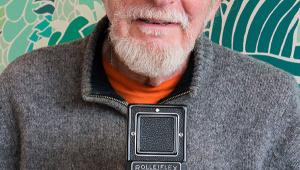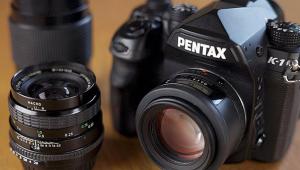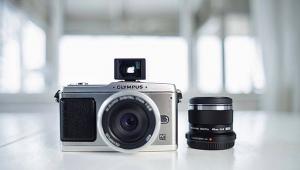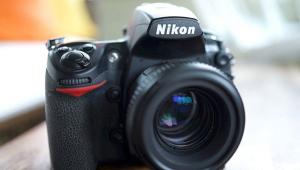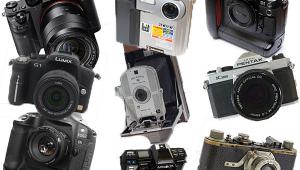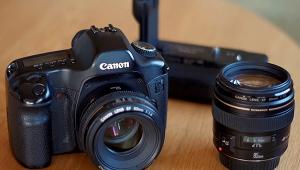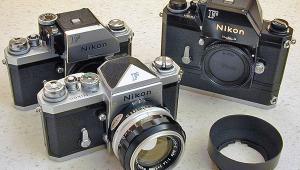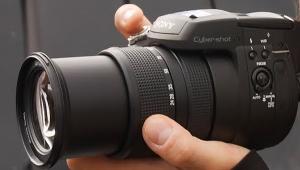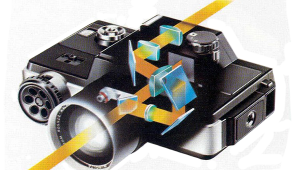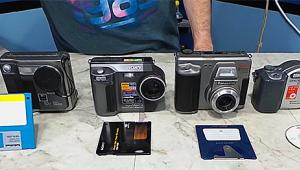8 Great Vintage Street Photography Cameras (Classic Film Models)
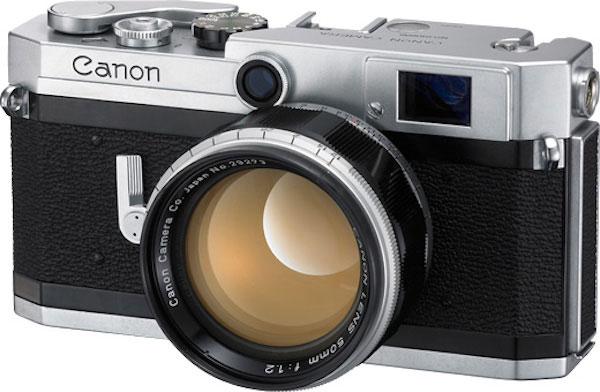
Practically any analog camera can be pressed into service as a street camera—the late great Weegee used a 4x5 Speed Graphic to expose the seamy and sentimental sides of New York City, and the incomparable Vivian Maier stalked the streets of Chicago with a twin-lens Rolleiflex. But when it comes to discreet shooting on the fly, nothing can quite match a 35mm rangefinder camera as proven by the timeless work of countless photojournalists over the past 90 years.
I’ve shot with many of them myself, including each of the 8 Great Vintage Street Photography Cameras listed below, and I can commend them to anyone who enjoys capturing images of people being themselves. Needless to say, this list is not intended to be definitive, and if it inspires you to check out other great film cameras that fill the bill, by all means do.
If you’re interested in street photography, you should also check out my story from December 2018 where I choose my 10 favorite street photography cameras, which only includes current models. Happy hunting!
1. Leica M4

Any M-series Leica rangefinder, analog or digital, qualifies as a great street camera, but the classic M4’s combination of understated elegance, Spartan simplicity, quiet precision, and unsurpassed performance make it a top choice. Introduced in 1966, it combined the features of its predecessors the M3 and M2 and added a few of its own, all aimed at enhancing convenience and flexibility. Its superb 0.72x range/viewfinder provides projected, parallax-compensating frame lines for 35 mm, 50mm, 90mm and 135mm lenses and it has a more conveniently angled plastic-tipped film-wind lever, more contemporary looking self-timer and frame line-selector levers, and an ingenious angled film rewind crank in lieu of the traditional pullout knob on the M3 and M2. It also employs a fixed, 3-slotted take-up shaft instead of a removable spool that makes film loading quicker, more secure, and less fiddly. The Leica M4 is considered by many Leica aficionados to represent the high point in the evolution of the Leica M due to its exquisite range/viewfinder design and its unsurpassed mechanical quality.
Fitted with a superb (non-ASPH) 35mm f/2 Summicron-M or 35mm f/1.4 Summilux-M lens it’s a street shooter’s dream, but at 4-5 grand so equipped it’s not for the faint of wallet.
2. Canon VI-T, VI-L

Introduced in 1959, this splendid pair of interchangeable-lens, rangefinder Canons are tops in terms of features and overall quality, and they’re superb street cameras, especially when fitted with fast, high-performance wide-angle lenses like the excellent 35mm f/1.8 Canon of the era. Both the trigger-wind VI-T (image above) and lever-wind VI-L (image at the top of this story) feature a three-position range/viewfinder showing the fields of 35mm and 50mm lenses plus a 1.5X setting for critical focusing, auto-parallax adjustment of shoe-mounted finders (!), titanium focal-plane shutter with speeds from 1-1/1000 sec plus T and B, folding rewind crank, and Leica-derived 39mm screw mount. To this magnificent mix, they added parallax-compensating finder frame lines for 50mm and 100mm lenses, a top-mounted, non-rotating shutter dial for setting all speeds 1-1/1000 sec plus B, X sync, a double lock on the hinged back, a self-zeroing frame counter, and back-mounted film type reminder dial.
Most often found with 50mm f/1.8, 50mm f/2.8 or 50mm f/1.2 Canon lens, they’re also premier user collectibles currently fetching $200-$400 (body only) depending on condition, on the used camera market.
3. Nikon SP

The ultimate iteration of the classic, interchangeable-lens Nikon rangefinder camera and perhaps the most famous, the signature feature of the Nikon SP inrtroduced in 1957 is the distinctively shaped, wide window for the viewfinder, which includes projected, parallax-compensating framelines for focal lengths from 50-135mm and a separate built-in viewfinder for 28mm and 35mm lenses. The latter feature makes it an especially good chice for street shooters that favor wide-angle lenses such as the outstanding 35mm f/1.8 W-Nikkor.The SP was also compatible with an electric motor drive, popular among photojournalists and sports photographers. Features include: Single stroke film-wind lever, cloth focal-plane shutter with speeds of 1/1000 sec plus B, and self-timer. Most common normal lenses: 50mm f/1.4 or f/2 Nikkor.
The Nikon SP is most often found in chrome finish, and really clean examples currently run about $1,000-$1,500 (body only). The later Nikon S3 and S4 (street price $900-$1,200, body only) also make great street cameras. Both have fixed, non-parallax-compensating viewfinder framelines, but this isn’t a major disadvantage in street photography.
4. Zeiss Contax IIa/IIIa
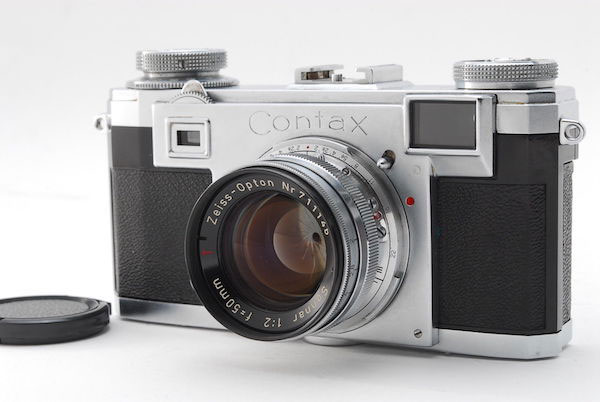
One of the truly great interchangeable-lens 35mm rangefinder cameras of the ‘50s and early ‘60s, the Contax IIa was an upgraded, improved version of the landmark Contax II of 1936. It retained its superb long base, combined range/viewfinder and top-mounted, non-rotating shutter-speed dial which sets the full range of shutter speeds from 1to 1/1250 sec plus B. The shutter release is conveniently and cleverly inset in the center of the wind knob, and there’s a conventional mechanical self-timer lever on the front. The classic Contax internal bayonet mount was retained, allowing full lens interchangeability between models, but outer bayonet lugs were added to provide a more stable platform for heavy telephoto lenses. Other classic Contax features include milled finger-wheel focusing, a simplified, more reliable version of the signature roller blind, vertical-travel metal focal-plane shutter, and a removable back with bottom-mounted twist lock. Besides being technologically advanced, the Contax IIa is an exquisitely made, high performance machine. The superb line of Zeiss lenses includes the 50mm f/1.5 Sonnar, and the 35mm f/2.8 Biogon, both favored by street photographers. A companion model, the Contax IIIa is basically a Contax IIa with built-in uncoupled selenium meter added. The only downside: Zeiss never got around to adding viewfinder frame lines to their magnificent creation, so you’ll have to add a separate shoe-mount viewfinder if you want to shoot in the street with wide-angle lenes. The upside: Nikon S rangefinder wide-angles fit and function perfectly.
Used street price Contax IIa or IIIa : $150-200 body only; $350-450 with 50mm f/1.5 Sonnar.
5. Canonet G-III QL 17

A best buy among analog vintage street cameras, Canon’s well-made, high-performance, non-interchangeable lens, compact rangefinder 35 of 1972 sports a sharp 6-element, 4-group 40mm f/1.7 Canon lens, that focuses to 2.6 feet, a nice 0.6x range/viewfinder with projected parallax-compensating frame line, manual, and shutter-priority auto-exposure via a CdS cell in the lens surround. Its in-lens leaf shutter provides speeds of 1/4-1/500 sec plus B. AE-chosen f/stops are read out in the finder, and there’s a battery check, a self-timer, a large ergonomic wind lever, and an AE exposure lock by holding the shutter release partway in. The “QL” stands for quick loading, and there’s a film loading verification window, and auto flash capability with a dedicated accessory Canolite D. Downsides: No metered manual exposure. And since it was designed to take banned PX625 mercuric-oxide batteries you have to either use short life 1.35v zinc-air cells or have the camera modified by adding a diode so it will give accurate exposure readings with available equivalent 1.5v alkaline or silver-oxide batteries (about $25).
Used street price range: $100-$200.
6. Olympus 35 SP
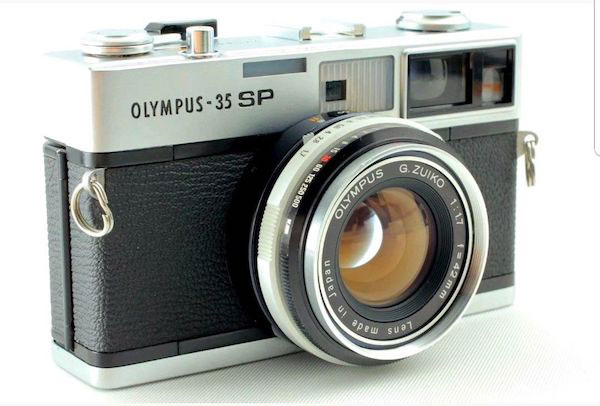
Remarkably advanced for its day (1969-1976), this superlative compact rangefinder 35 is unique in featuring a dual CdS metering system giving a choice of a 20-degree central field or a 6-degree spot roughly corresponding to the center rangefinder patch, and it provides programmed auto-exposure and metered manual mode. Street shooters will be thrilled with the stellar performance of its 7-element 4-group 42mm f/1.7 G. Zuiko lens that delivers outstanding sharpness wide open or stopped down, and its full-range leaf shutter with speeds on 1-1/500 sec plus B. Its large, bright 0.7x viewfinder has a frame line with parallax compensation marks for composing the shot at its 2.8-foot minimum focus distance, but no parallax compensation—not a big deficit for street shooters. Other features: Exposure lock via the shutter release, hot shoe and PC contacts, ASA 25-800 film speed settings. Downsides: Metering in manual mode is inconvenient, and since it was designed to take PX625 mercury batteries (1.35v) you’ll have to either use short life 1.35v zinc-air cells or have the camera modified (about $25) by adding a diode so it will give accurate exposure readings with available equivalent 1.5v alkaline or silver-oxide batteries.
Used street price range: $100-$200 in chrome, $300-400 in black.
7. Minolta CLE

Minolta’s audacious CLE was the high-tech successor of the Leica/Minolta CL a compact M-mount rangefinder camera designed by Leica and Minolta, introduced in 1973, and marketed under both brands. The CLE of 1980 is still one of the most advanced M-mount cameras ever made, and it was 100% Minolta. It has parallax-compensating projected viewfinder frame lines for 28mm 40mm, and 90mm lenses and electronically controlled 1-1/1000 sec plus B focal-plane shutter. Its TTL silicon photodiode (SPD) metering system provides aperture-priority automatic and manual exposure, and also offers an automatic ambient/flash exposure system that makes adjustments during the exposure by taking readings off the film (OTF) while the shutter is open. And, as in the then-current Olympus OM-2n the SPD cell takes ambient light readings reflected off the patterned shutter curtain. While sophisticated auto-exposure is a plus for street shooters the chief attraction of the CLE is the lenses, which are superb. They include a 7-element, 5-group 28mm f/2.8 Rokkor and a 6-element 4-group 40mm f/2 Rokkor said to be equal to ther Leica counterparts. And of course the camera will accept most M-mount lenses though you may require a separate shoe-mount viewfinder with some focal lengths.
Used street price: $500-750, body only, $1,200-$1,500, kit with case, lens, etc.
8. Rollei 35
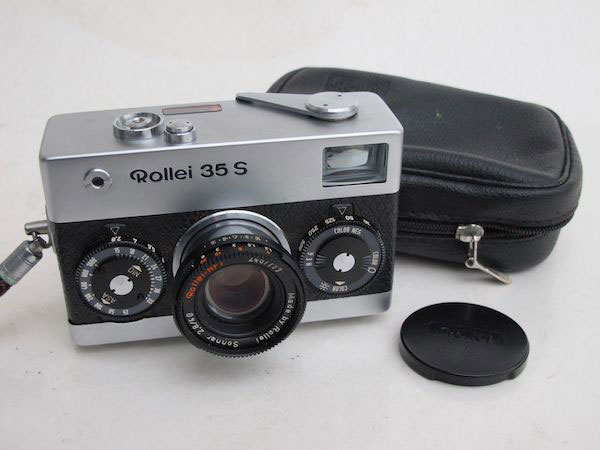
This exquisitely compact, collapsible-lens, full-frame (24x36mm) 35mm camera introduced in 1966 harks back to the original concept of the Leica A of 1925, a high precision, scale-focusing manual 35mm that fits in a pocket or purse. Its semi-wide-angle lens is perfect for street shooting. The original Rollei 35, that sports a collapsible, front-cell-focusing 40mm f/3.5 Carl Zeiss Tessar lens, Rollei-Compur shutter with speeds from 1/2 to 1/500 sec, and optical frame line viewfinder, created an instant sensation and became a best seller despite its high price. With its external CdS match-needle metering system, bottom-mounted wind lever and hot shoe, and the need to cock the shutter before collapsing the lens, the Rollei 35 is not the last word in convenience, but in sheer picture-taking ability per unit of volume and visceral appeal, it’s hard to beat. Originally made in Germany, production was later transferred to Singapore, where other models (the Rollei B 35, 35 LED, 35T and 35TE) were made. In terms of performance, the Singapore-made Rollei 35S, and German-made Rollei 35 Classic, both with unit-focusing 40mm f/2.8 Sonnar lenses, are the best of the bunch in terms of image quality, but all are great, pocket-sized walk-around cameras. German-made models fetch fancy prices among collectors but Singapore-made models are cheaper and perform just as well.
Current used price range for a Rollei 35S made in Singapore: $225-$450.
Editor's Note: You should also check out "The Top 10 Street Photography Cameras (Current Models)" for a look at contemporary, digital street cameras.


